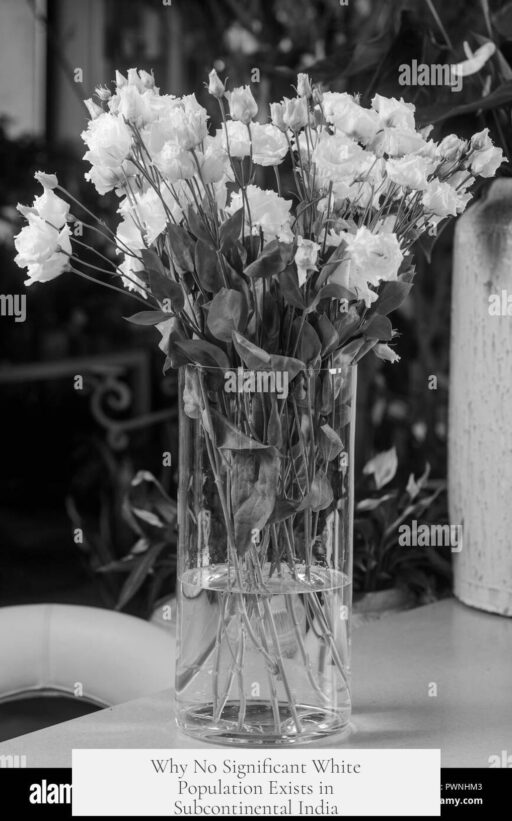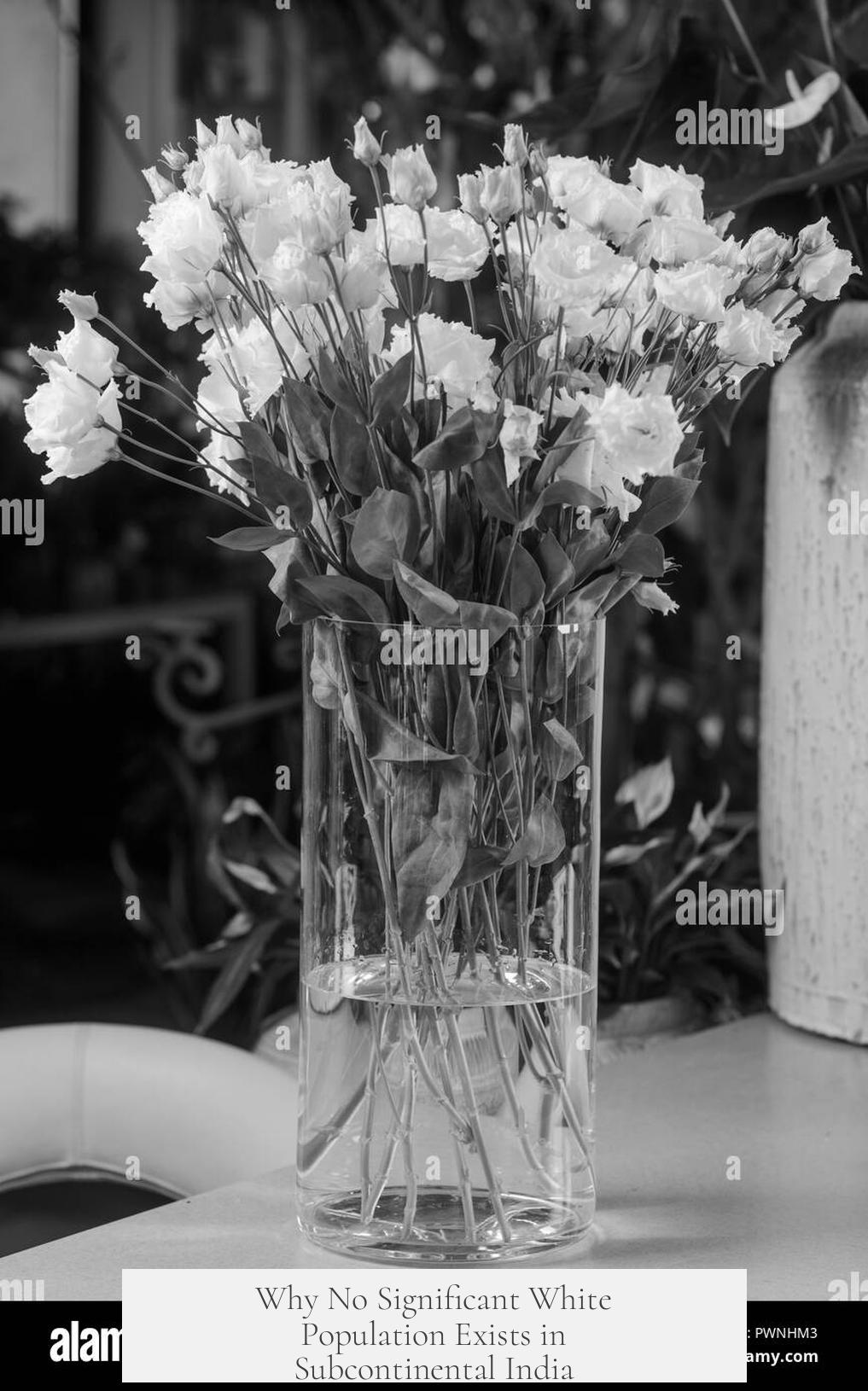There isn’t a significant population of white people in the Indian subcontinent due to historical, demographic, social, and economic factors shaped over centuries of interaction between Europe and India.

During the British Raj era, which lasted less than 100 years from the 1850s to the late 1940s, many European officials and families lived in India. However, they often maintained separate social circles and lived segregated lives. Most Europeans, including those from the East India Companies (English, French, Dutch), were young, single men focused on trade and military careers. Many returned to Europe after gaining wealth or died due to disease and conflict, limiting the foundation for large European descendent populations. Those who stayed saw gradual assimilation or intermarriage with locals.
The East India Companies employed many Europeans whose goal was profit through spice trade and military alliances. These companies were private entities, not governments, which meant transient populations rather than permanent settlers. Soldiers and traders were few, often young, and mortality was high. Over time, some veterans returned home to marry and begin families, rather than settling long-term in India.

Intermarriage plays a vital role in the cultural landscape of colonial India. Many British men married local Indian women, forming Anglo-Indian communities. At the peak of this interaction, about one-third of British officials had Indian wives or mixed children. For instance, James Skinner, known as Sikandar Sahib, was a notable figure born from a Scottish father and Rajput mother. These generations adopted Indian customs, languages, and religions, blurring clear ethnic lines. The Anglo-Indian community formed a unique identity distinct from European groups but did not constitute a large, separate white population.
Post-independence, many Europeans and Anglo-Indians emigrated from India due to shifting political and social climates. The Indian Constitution of 1950 recognized the Anglo-Indian community by reserving seats in the Lok Sabha, illustrating attempts at inclusion despite their dwindling numbers. Yet intermarriage diluted distinct European physical traits across generations. Hence, the noticeable “white” population diminished as identities merged with broader Indian demographics.

Demographically, India’s population is immense—approximately 1.5 billion people—and hosts various ethnic groups and communities. Even a few thousand white expatriates or descendants form a tiny fraction of the total. Tourists and expats from Europe visit or reside in India, but their numbers are not substantial enough to influence overall population statistics or cultural visibility substantially.
| Population Factor | Effect |
|---|---|
| Large Indian population (1.5 billion) | White population remains a statistically negligible minority |
| Few thousand white expats | No visible demographic impact |
| Anglo-Indian assimilation | Mixed heritage complicates distinct racial identification |
Economic and cultural dynamics in India differ from other colonies like South Africa. In South Africa, the white minority historically controlled much of the wealth and business, allowing them to live largely apart from indigenous populations. India’s wealth was locally widespread and not dominated by a white minority, prompting necessary cultural bridging and integration between Europeans and Indians. This integration reduced social segregation and encouraged cultural assimilation rather than the formation of isolated white communities.

Colonial ambitions in India focused principally on resource extraction and control of strategic trade routes, rather than large-scale European settlement. This contrasts with settler colonies where white populations grew through migration. India already had an abundant labor force producing resources, so the British prioritized local recruitment for administration and policing needs rather than sending large numbers of Europeans as settlers or soldiers.
In fact, most soldiers policing India during British rule were locally recruited, unlike in places such as South Africa where many military personnel were European immigrants. This logistical approach meant fewer Europeans were needed on the ground, lessening the potential for a growing permanent white population.

- European interaction was mainly short-term or trade-focused, limiting permanent white settlement.
- High mortality among European traders and soldiers reduced long-term European population growth.
- Intermarriage and cultural assimilation created a mixed Anglo-Indian community rather than distinct white enclaves.
- India’s massive population dwarfs the small numbers of Europeans and expats present.
- Economic wealth was not concentrated in Europeans, prompting cultural bridging rather than segregation.
- Colonial goals emphasized resource control, not population replacement or settler growth.
- Local recruitment of soldiers and administrators minimized the need for a large European military presence.
Why Isn’t There Really a Population of White People Within Subcontinental India?
Simply put, white populations never took root in India in any significant, lasting way due to historical, demographic, cultural, and economic reasons intertwined over centuries. The idea of a large white community existing within the subcontinent is a myth shaped by colonial narratives and common misconceptions. When you peel back the layers, the reasons become clear, interesting, and even a bit unexpected.
Ever wondered why, despite British colonialism and earlier European presence, India doesn’t showcase neighborhoods or towns known as “Little England” or “White-Indianville”? Let’s unravel this with a dose of history, facts, and some real-life twists.
A Short Journey Through History: Europeans in India
First off, the European presence in India was never about settling massive white populations. When Britain ruled India under the British Raj from roughly the 1850s to 1947, the European community never grew beyond a small fraction of the population. Why? The British administrators and families mostly lived segregated lives, in enclaves or hill stations designed for their comfort. Many left India soon after independence, cutting their historical stay short.
Before the Raj, during the East India Companies era, European presence was largely young, single men focused on trading spices and goods. These were not immigrant families but mainly company men—soldiers, traders, and sometimes mercenaries, frequently battling diseases and conflicts with high mortality rates. Most returned to Europe wealthy, but not permanently settled in Indian soil.
The implication? The European presence was transient and business-driven, not population- or colony-building like in parts of Africa or the Americas.
Mixing Cultures and Breaking Racial Lines
Now here’s a twist: many Europeans who stayed did intermarry with locals. This led to the rise of the Anglo-Indian community—a unique cultural blend rather than a separate, purely white population. Historical records show that up to one-third of British officials reportedly had Indian wives or Anglo-Indian children.
These communities assimilated deeply: adopting local languages, religions, and customs, producing figures like James Skinner (aka Sikandar Sahib), a military leader with Scottish and Rajput roots. Over generations, “white” identity blurred and merged into local identities.
So, instead of distinct white colonies, what you have is a mixed population with both European and Indian bloodlines. Thanks to decades of intermarriage, strict racial lines faded, and a recognizable overtly white population simply didn’t persist.
A Sea of People Makes a Few Drops Invisible
Think of India’s scale. It’s home to nearly 1.5 billion people. Even thousands of white foreigners—tourists, expats, business people—are statistically minuscule. Imagine 50,000 visitors in a country the size of India; they visually blend into the crowd like a grain of rice among a mountain of grains.
Contrast that with South Africa, which historically had a small, concentrated white settler population controlling economic power. In India, European arrivals never approached such demographic weight. Just because a white population might serve as a ruling minority does not mean they swell in sheer numbers.
Economic Realities and Cultural Necessities
One major reason why white populations thrived as distinct groups in places like South Africa but not in India is economic power distribution. In South Africa, the white minority held nearly all significant wealth and businesses. They lived separately and had little incentive to blend culturally.
In India, wealth and power were more diffusely distributed among local elites, with Europeans sharing and depending on Indian cooperation. Business and governance required cultural bridging. Many Europeans learned local languages and integrated aspects of Indian customs to function effectively. They could not isolate themselves completely.
The reality? To thrive in India, Europeans had to both live with and as Indians to a considerable degree. Segregation usually meant disadvantage, so distinct white enclaves didn’t last.
Colonial Goals: Not to Populate, But To Control
Colonial powers rarely intended to populate colonies in the way permanent migration suggests. The goal was resource extraction. In India’s case, colonial rulers wanted access to spices, cotton, textiles, and strategic advantages, not to replace or excessively resettle the population.
Moreover, India already had a massive, abundant workforce. Labor shortage? No. Thus, colonial rulers recruited soldiers and police locally to maintain control. Unlike South Africa’s mostly white settler soldiers, British forces in India were mainly Indian troops led by British officers. It made logistical and cultural sense.
The takeaway: the colonial approach was resource and control-centric, not demographic transformation.
Cultural and Demographic Mixing = No “White India” Community
Connecting these threads reveals why a substantial white population in India never formed:
- European men often stayed temporarily, returning to Europe to start families.
- Those who remained typically formed mixed communities, blending identities.
- India’s gigantic population dwarfed European numbers.
- Economic and social dependency encouraged cultural assimilation.
- Colonial goals prioritized control, not settlement.
Historical attempts to maintain strict racial divides faded over time because India’s complex society demanded cooperation and shared identities.
So, is There Really No White Population in India Today?
Well, there are certainly white people in India—tourists, expats, diplomats, and a small number of naturalized citizens. But their presence is numerically negligible compared to India’s giant and diverse population. Most white ancestry within the Indian population is internalized through mixed heritage communities like the Anglo-Indians.
When people ask why you don’t see a “white India,” think of it less as an absence and more as a blending, where boundaries fade. The legacy is not in segregated white towns or large communities but in shared histories, cultural exchanges, and a fusing of bloodlines and identities.
What Can We Learn from This?
This story challenges common assumptions about colonialism and race. Population control and cultural integration paint complex pictures overlooked when only focusing on race or imperialism alone. It reminds us to question simple narratives and to look deeper into human stories beyond skin color.
Next time you visit India or read about its history, remember that India’s diversity transcends simplistic racial categories. The subcontinent’s story involves mixing, mingling, and mutual influence rather than imposition and replacement.
Final Thought
Population size, colonial goals, and cultural mixing explain why India doesn’t have a noticeable white population within. Europeans came, stayed briefly, intermarried, assimilated, or left. The vast tapestry of Indian society embraced and absorbed them rather than segregating them permanently.
So no, you won’t find a “white India” community like you might in South Africa or America. Instead, what you’ll find is an incredibly rich, blended heritage frequently ignored in colonial histories but alive in thousands of stories, faces, and families across the subcontinent.
Why are there no significant populations of white Europeans living permanently in India?
Most Europeans who came to India during colonial times either stayed temporarily or returned home. Many European settlers lived segregated lives and left around independence in 1947. Large-scale permanent white settlements never took root here.
How did intermarriage affect the presence of white populations in India?
Many European men married local Indian women, creating Anglo-Indian communities. Over generations, these mixed communities assimilated fully into Indian culture, blending ethnic lines and reducing a distinct white population’s visibility.
Why does India’s large population mask the presence of any white communities?
India’s population is nearly 1.5 billion. Even thousands of white expats or descendants are proportionally small. This scale makes any white population hard to notice compared to smaller countries with visible white minorities.
Did economic or social factors in India prevent a large white settler population?
The wealth in India was widely distributed, unlike in colonies where whites controlled most wealth. Whites in India had to culturally bridge with locals and never formed a separate, dominant settler class.
Were colonial powers interested in settling Europeans in India permanently?
Colonial goals focused on controlling resources, not population replacement. India’s large labor force was sufficient, so colonial rulers relied on local recruitment instead of establishing a large permanent white settler population.




